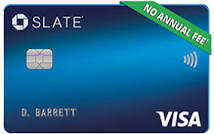- If you are making minimum payments on high-interest credit cards and you have a good credit score, you should explore balance transfer credit cards.
- A credit card balance transfer is refinancing your credit card debt.
- Before you start applying for balance transfer credit cards, post-introductory APRs, balance transfer credit card fees, and credit utilization are amongst few things you need to factor into your decision to transfer your outstanding balance (s) to a new credit card.
If you are making minimum payments on high-interest credit cards and you have a good credit score, you should explore balance transfer credit cards. A credit card balance transfer is refinancing your credit card debt. Most credit card issuers charge a balance transfer fee between 3 to 5 percent of the amount of the credit card debt you transfer. Chase Slate credit card even provides a 0% introductory balance transfer during the first 60 days your account is open.
Before you start applying for balance transfer credit cards, post-introductory APRs, balance transfer credit card fees, and credit utilization are amongst few things you need to factor into your decision to transfer your outstanding balance (s) to a new credit card. Below are the best balance transfer credit cards:
CITI SIMPLICITY® CARD-
FMC’s Note. You will have nearly 21 months to pay off your transferred amount without paying any interest. The Card does charge 5% of the amount of each transfer. So if you transfer $10,000, the fee will be $500.00 ($10,000×0.05)
Annual Fee. No Annual Fee
Transparency. The introductory rate of 0% for 12 months from date of account opening on purchases and an introductory rate of 0% for 21 months from date of first transfer for balance transfers. Balance transfers must be completed within four months of account opening. After each introductory period ends, the standard variable APR for purchases will be applied to unpaid introductory balances, new purchases, and new balance transfers. The standard variable APR for purchases and cash advances is 16.24% – 26.24%, based on your creditworthiness. Pl
Credit. You need “ Excellent, Good” credit to get approved- https://www.citi.com/credit-cards/credit-card-details/citi.action?ID=citi-simplicity-credit-card
Discover it® Balance Transfer
FMC’s Note. Discover It Balance Transfer has it all. It gives you 0% intro APR for 18 months on balance transfers. This is a card you can keep as your daily card as well because of its generous cashback which can be as high as 5% depending on the categories. Make sure that you pay off the transferred amount before turning the card into your go-to credit card.
Annual Fee. No Annual Fee
Transparency. After the intro APR expires, your APR will be 14.24% to 25.24%, based on your creditworthiness. This APR will vary with the market based on the Prime Rate. 3% of the amount of each transfer
Credit. You need “Good” credit to get approved- https://www.discover.com/credit-cards/cash-back/it-card.html.
Wells Fargo Platinum Card
FMC’s Note. Scandals or no scandals, Wells Fargo Platinum, is one of the best credit cards out there for balance. On top of its 0% intro APR for 18 months on balance transfers, its 13.74 to 27.24% after the intro APR is competitive.
Annual Fee. No Annual Fee
Transparency. 0.00% introductory APR for 18 months. After that, your APR will be 13.74% to 27.24%, based on your creditworthiness. This APR will vary with the market based on the U.S. Prime Rate. A balance transfer request must be made within 120 days from account opening to qualify for the introductory APR.
Credit. You need “Excellent, Good” credit to get approved- https://www.wellsfargo.com/credit-cards/platinum-visa/.
Blue Cash Everyday® Card from American Express
FMC’s Note. The Blue Cash Everyday Card from American Express has best of both world: 0.00% introductory APR for 15 months with a $150 cash back after you spend $1,000 in purchases in your first three months. You might need to forgo the $150 cashback and take advantage of the 15 months balance transfer.
Annual Fee. No Annual Fee
Transparency. After that, your APR will be 15.24% to26.24%, based on your creditworthiness and other factors as determined at the time of account opening. This APR will vary with the market based on the Prime Rate.
Credit. You need “ Good” credit to get approved- https://www.americanexpress.com/us/credit-cards/card/blue-cash-everyday/.
U.S. Bank Visa® Platinum Credit Card
FMC’s Note. The U.S. Bank Visa Platinum provides an 0.00% introductory APR for 18 months. Also, its post-introductory APR is quite competitive as well.
Annual Fee. No Annual Fee
Transparency. U.S. Bank Platinum Visa® Card: 0% introductory APR for the first 18 billing cycles for balances transferred within 60 days from account opening. After that, 14.74% to 25.74% based on your creditworthiness when you open your account.
Credit. You need “ Good” credit to get approved https://mycard.usbank.com/credit/mycardusb/html/usbank_platinum_visa.html.
Chase Slate Credit Card
FMC’s Note. With Chase Slate credit card, you can transfer balances with an introductory fee of $0.00 during the first 60 days your account is open.
Annual Fee. No Annual Fee
Transparency. Chase Slate credit card has a 0% intro APR for 15 months on purchases and balance transfers from account opening. After that, 16.99%–25.74% variable APR
Credit. You need “ Good” credit to get approved: https://creditcards.chase.com/balance-transfer-credit-cards/chase-slate.

Pingback: FMC Refinance Your Credit Card Debt Credit Cards - FMC